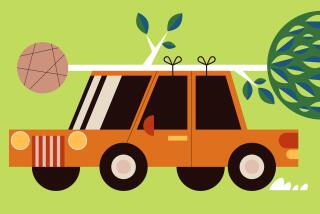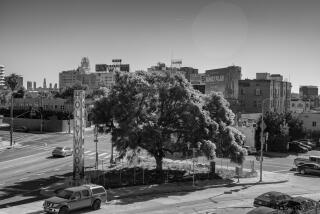How Green Is Your Christmas Tree? : Traditions: Artificial ones last forever and need no sawing. But folks who sell real--even living-- ones say theirs are just as environmentally correct.
- Share via
Ira Lyon is preparing for a busy weekend at Lyon’s Christmas Tree Farms in Rosemead.
“I predict that 38% of this year’s Christmas trees will be bought this weekend,” says Lyon, California’s largest Christmas tree grower. “We’re ready.”
Lyon’s farm is one of 40 in the Los Angeles area where families can choose and cut their trees. Lyon provides the saw.
“We grow only Monterey pines,” he says, “and I have 10 employees working year-round shaping the trees. Our price is $24.95, whatever the size.”
Other tree farms offer different prices and types. Shoppers in Los Angeles and Orange counties can find the nearest one by calling California Christmas Tree Growers, (800) 454-8733.
“Choose and cut” is one of the options for this year’s Christmas tree buyers and will account for about 1.5 million trees in California, according to the California Christmas Tree Growers.
Another 3 million will be pre-cut and sold at nurseries, garden stores and on Christmas tree lots. Scotch pine is the runaway favorite every year, followed by Douglas fir, white pine and balsam fir. The cost this year ranges from $3 to $5.65 per foot, Lyon says.
Whatever type of tree you choose, tree experts say, do this freshness test on several candidates before you make a choice:
Gently grasp a branch and pull it toward you. Do the needles come off? Does the branch snap? If so, the tree is old. Look at the ground around the tree. Some loss of interior brown needles is normal and will occur over the lifetime of the tree, but you shouldn’t see an excessive number of green needles.
Sap seals the base soon after a tree is cut, so when you get it home, make a fresh, straight cut across the base of the trunk (about half an inch up from the original cut) to allow the tree to absorb water.
A cut tree is very thirsty: It will absorb as much as a gallon of water in the first 24 hours and one or more quarts a day thereafter. Use a stand that holds two or more quarts and keep it full. Adequate water prevents the needles from drying and the boughs from drooping.
This care also keeps the tree from becoming a fire hazard.
“People often don’t think that re-cutting the trunk is important, but it is,” says Gary Jenkins of the Los Angeles City Fire Department. “They also need to think about where they put it--keep the tree away from heat and draft sources like fireplaces, radiators and television sets. And it’s very important to test your Christmas tree lights and use only lights that have the UL label, which means they have been tested for safety by Underwriters Laboratories.”
The same safety rules apply to living Christmas trees in pots, which most growers also sell. “It’s a niche market, but not large--maybe 2%,” Lyon says. “They’re a lot of extra work.”
Living trees have been popular for the past few years as a compromise for environmentalists who view cut trees as a waste and a burden on landfills.
But Rena Kilmor at Treepeople, a Los Angeles environmental group, has a warning about living trees. “It’s a bit like buying a puppy,” she says. “They’re cute, but you have to remember they’re going to grow up. After Christmas, we get abandoned trees in pots on our doorstep from people who don’t know what to do with them.
“Take a good look at your house and remember the tree will grow dramatically,” Kilmor says.
For those still interested, she offers these tips:
* Buy a tree that will do well in our climate, which means it needs to be smog- and drought-tolerant. Canary Island pine, Deodar cedar, Italian stone pine and Japanese black pine all do well in this area.
* Plant the tree properly with drainage and the correct soil. And be careful about over-fertilizing, which could cause the tree to go into shock. Be aware that some nurseries have already heavily fertilized to make the tree look better. Living tree prices depend on the species and the size. A sample range: two-gallon stone pine, two feet tall, $9.95; seven-gallon, five-foot Aleppo pine, $29.95; 15-gallon, seven-foot Aleppo pine, $49.95; 15-gallon, eight-foot Monterey pine, $59.95.
After considering the care and feeding of a live or cut Christmas tree, the shopper may understand the growing popularity of artificial trees, the choice of about half of American Christmas tree consumers.
“It’s a tough call for environmentalists,” Kilmor says. “(Artificial trees) are made out of petroleum products, but the positive side is that you can use them over and over again.”
The National Christmas Tree Assn. has launched an aggressive “Real Trees for Real People” campaign emphasizing that Christmas tree farms replenish the oxygen supply, serve as wildlife habitat, increase soil stability and provide scenic green belts where other crops wouldn’t grow.
Fans of fake trees respond that their trees don’t require anything to be chopped down, they can be easily stored and used every year, and, after 20 years of development, are realistic enough to fool a lumberjack.
A typical retail range is $24.95 for a three-foot-tall artificial Canadian pine to $200 for a six-footer.
New York importer Bradley Spitz says the artificial trees have been improved until “the quality is exceptional.”
With prices that range from a few dollars “into the thousands,” a shopper can match anything in the real tree world, Spitz says. “A lot of people like them because they can just fold them up and shove them into a box until next year. And they aren’t flammable.”






